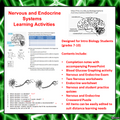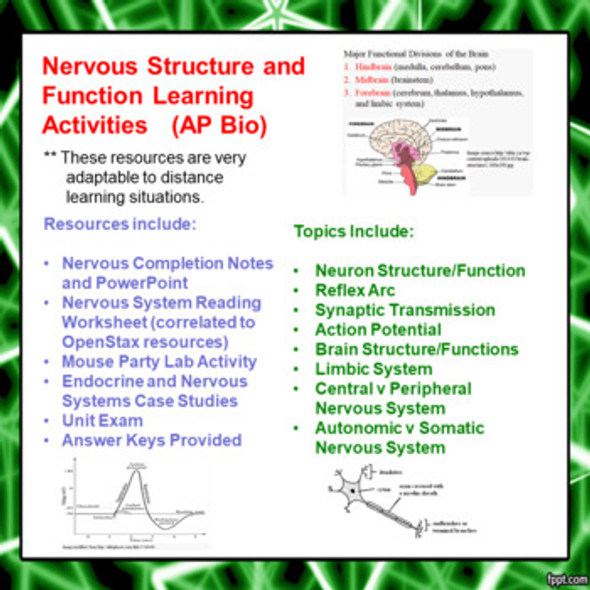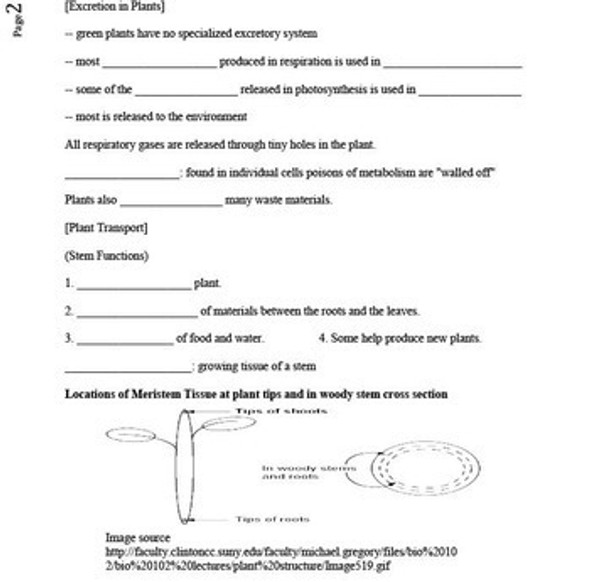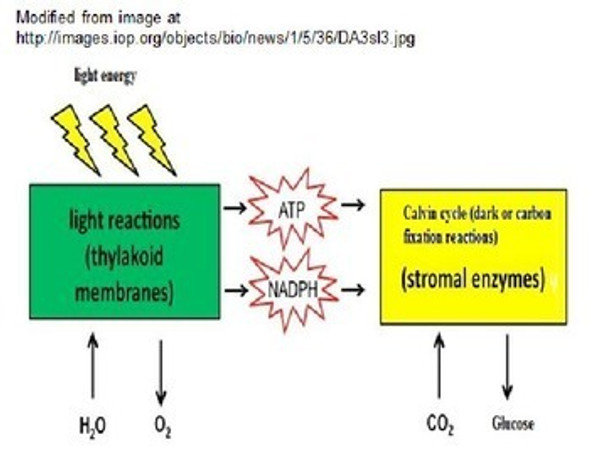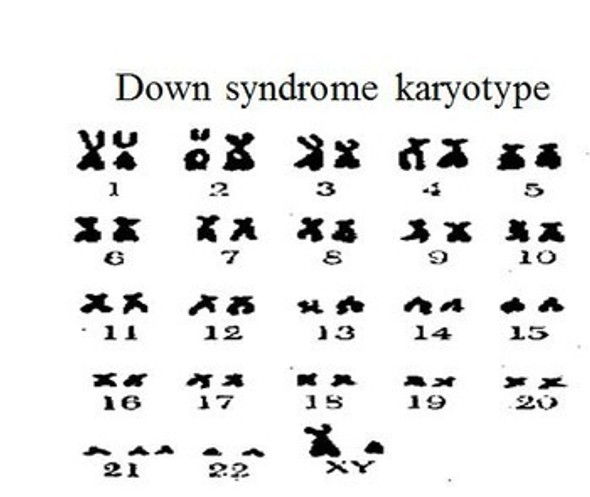Description
This zip file contains 11 different activities (42 different pages) which can be used to compose a unit for biology students introducing them to Nervous and Endocrine structure and function. While these lessons were originally designed to correlate to the performance indicators of the New York State Living Environment/Biology curriculum, the components of this lesson may be easily used in other biology courses as well. Documents have been posted in both pdf format and as editable word documents to allow you to tailor the materials to suit your course. These activities are well suited for use in distance learning environments.
Specifically it contains the following items:
- Marzano self assessment scale for students specific to this unit
- Cloze completion notes handout for students with learning goals (6 pages)
- PowerPoint to accompany the cloze notes (49 frames containing 3 bell ringer activities with answers)
- Blood Glucose Graphing activity (3 pages)
- Nervous and Endocrine Student Examination with key (8 pages)
- Nervous worksheet 1 with key (18 questions with different formats -- 3 pages)
- Nervous worksheet 2 with key (10 questions with different formats -- 2 pages)
- Endocrine worksheet with key (24 questions -- 5 pages)
- Nervous student practice quiz with answers (34 questions of varying format-- 6 pages)
- Endocrine student practice quiz with answers (29 questions of varying format -- 4 pages)
- Nervous and Endocrine Crossword Puzzle with key (2 pages)
Nervous and Endocrine Learning Goals
Upon the completion of this unit the student will:
1. recognize that nervous control depends mostly upon the functioning of neurons (nerve cells).
2. define the term stimulus and list examples of this.
3. define the following terms; impulse, receptors, response, and effectors.
4. define the term neuron.
5. given a neuron diagram, correctly identify the following structures; cyton, dendrites, axon, myelin sheath, terminal branches, and synapse.
6. state the function of the structures stated in learning goal # 5.
7. explain what is meant by a neurotransmitter.
8. describe the steps involved in the transmission of an impulse between neurons.
9. recognize that responses involve the action of effectors.
10. describe some ways that organisms detect and respond to changes at the organism and cellular level.
11. explain what is meant by a central nervous system.
12. given a diagram of a human brain, correctly identify the cerebrum, cerebellum and medulla.
13. state the chief function of each brain region listed in objective # 12.
14. explain how hormones are transported in the human body.
15. explain what is meant by a target organ.
16. recognize that hormones have specific shapes that fit with receptors on the surface of the target organ or structure they are going to influence.
17. recognize that hormones interact and exert control on metabolic activities such as reproduction and development.
18. recognize that the nervous and endocrine systems interact to control and coordinate the body response to changes in the environment.
19. state the chief function(s) and site of production of the following hormones; insulin, adrenaline, testosterone, estrogen, and progesterone.
20. state the chief cause of diabetes and list several major symptoms of this order.
21. explain what is meant by a feedback mechanism..
22. compare the nervous and endocrine systems in reference to the chemicals they produce, the duration of their responses, and the mechanism by which their chemicals are carried.
NGSS Standards
HS-LS1-2. Develop and use a model to illustrate the hierarchical organization of interacting systems that provide specific functions within multicellular organisms.
HS-LS1-3. Plan and conduct an investigation to provide evidence that feedback mechanisms maintain homeostasis.
Common Core State Standards Connections:
ELA/Literacy
WHST.9-12.7 Conduct short as well as more sustained research projects to answer a question (including a self-generated question) or solve a problem; narrow or broaden the inquiry when appropriate; synthesize multiple sources on the subject, demonstrating understanding of the subject under investigation.
Living Environment Core Curriculum Performance Indicators and Major Understandings
Performance Indicator 4,1
Explain how organisms, including humans, reproduce their own kind.
Major Understandings
4.1e Human reproduction and development are influenced by factors such as gene expression, hormones, and the environment. The reproductive cycle in both males and females is regulated by hormones such as testosterone, estrogen, and progesterone.
Performance Indicator 5.1
Explain the basic biochemical processes in living organisms and their importance in maintaining dynamic equilibrium.
Major Understanding
5.1g Enzymes and other molecules, such as hormones, receptor molecules, and antibodies, have specific shapes that influence both how they function and how they interact with other molecules.
Performance Indicator 5.3
Relate processes at the system level to the cellular level in order to explain dynamic equilibrium in multicelled organisms.
Major Understandings
5.3a Dynamic equilibrium results from detection of and response to stimuli. Organisms detect and respond to change in a variety of ways both at the cellular level and at the organismal level.
5.3b Feedback mechanisms have evolved that maintain homeostasis. Examples include the changes in heart rate or respiratory rate in response to increased activity in muscle cells, the maintenance of blood sugar levels by insulin from the pancreas, and the changes in openings in the leaves of plants by guard cells to regulate water loss and gas exchange.
Appendix A – Lab Skills
¥ Identifies the control group and/or controlled variables
¥ Organizes data through the use of data tables and graphs
¥ Analyzes results from observations/expressed data
Bundle and Save!
Many more biology materials are available from Monday's Rescue. The Biology/Life Science Course contains 22 units which can be used to develop a full year course. A purchase of the Biology/Life Science Course provides significant savings of over 70% compared to purchasing each of the 22 units individually. This course is available for $24.99. It contains over 900 pages of learning materials and 1500 plus PowerPoint slides.
This year long course contains the following units;
- Life Processes and Introduction to Classification Learning Activities
- Cell Structure and Function Lesson Activities
- Membrane and Membrane Processes Learning Activities
- Introduction to Biochemistry and Enzymes Lesson Activities
- Human Nutrition Learning Activities
- Human Circulation Learning Activities
- Immunity Lesson and Lab Activities
- Human Respiration Learning Activities
- Introduction to Cell Respiration Learning Activities
- Introduction to Human Excretion and Human Locomotion Learning Activities
- Nervous and Endocrine Systems Lesson Activities
- Introduction to Mitosis and Asexual Reproduction Lesson Activities
- Introduction to Meiosis Lesson Activities
- Reproduction and Development Lesson Activities
- Plant Systems and Adaptations Lesson Activities
- Photosynthesis Learning Activities
- Plant Reproduction and Development Lesson Activities
- Classical Genetics Learning Activities (Mendelian and Beyond Mendel)
- Introduction to DNA, RNA, Protein Synthesis and Biotechnology Lesson Activities
- Introduction to Evolution Lesson Activities
- Ecology Lesson Activities
- Human Ecology Learning Activities
- Complete NY State Living Environment Regents Review Packets with Answers
View the contents of the whole year course in more detail at Biology/Life Sciences Complete Course
Terms of Use
Purchase of the product is for classroom use by the purchaser only. It is a violation for individuals, schools, and districts to redistribute or sell this item on the Internet or to other individuals. I do encourage you to use and edit these documents to suit your needs with your own students in distance learning environments.
This work is licensed under a Creative Commons Attribution-NonCommercial-ShareAlike 4.0 International License.




